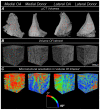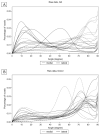Quantitative three-dimensional collagen orientation analysis of human meniscus posterior horn in health and osteoarthritis using micro-computed tomography
- PMID: 33588085
- PMCID: PMC7610734
- DOI: 10.1016/j.joca.2021.01.009
Quantitative three-dimensional collagen orientation analysis of human meniscus posterior horn in health and osteoarthritis using micro-computed tomography
Abstract
Objective: Knee osteoarthritis (OA) is associated with meniscal degeneration that may involve disorganization of the meniscal collagen fiber network. Our aims were to quantitatively analyze the microstructural organization of human meniscus samples in 3D using micro-computed tomography (μCT), and to compare the local microstructural organization between OA and donor samples.
Method: We collected posterior horns of both medial and lateral human menisci from 10 end-stage medial compartment knee OA patients undergoing total knee replacement (medial & lateral OA) and 10 deceased donors without knee OA (medial & lateral donor). Posterior horns were dissected and fixed in formalin, dehydrated in ascending ethanol concentrations, treated with hexamethyldisilazane (HMDS), and imaged with μCT. We performed local orientation analysis of collagenous microstructure in 3D by calculating structure tensors from greyscale gradients within selected integration window to determine the polar angle for each voxel.
Results: In donor samples, meniscus bundles were aligned circumferentially around the inner border of meniscus. In medial OA menisci, the organized structure of collagen network was lost, and main orientation was shifted away from the circumferential alignment. Quantitatively, medial OA menisci had the lowest mean orientation angle compared to all groups, -24° (95%CI -31 to -18) vs medial donor and -25° (95%CI -34 to -15) vs lateral OA.
Conclusions: HMDS-based μCT imaging enabled quantitative analysis of meniscal collagen fiber bundles and their orientations in 3D. In human medial OA menisci, the collagen disorganization was profound with overall lower orientation angles, suggesting collagenous microstructure disorganization as an important part of meniscus degradation.
Keywords: Collagen organization; Contrast agent free micro-computed tomography; Meniscus microstructure; Osteoarthritis; Structure tensors.
Copyright © 2021 The Author(s). Published by Elsevier Ltd.. All rights reserved.
Conflict of interest statement
AT works as an associate editor (statistics) in Osteoarthritis and Cartilage.
ME has received grants from European Research Council, The Swedish Research Council, the Foundation for Research in Rheumatology, the Greta and Johan Kock Foundation, the Swedish Rheumatism Association, the Österlund Foundation, the Governmental Funding of Clinical Research program within the National Health Service in Sweden, and the Faculty of Medicine, Lund University, Sweden.
ME reports in 2019 serving on an advisory board for Pfizer (Tanezumab).
SS has received grants from Foundation for Research in Rheumatology and European Research Council.
Other authors (VK, IK, MF, EF, PÖ, VH, and JT) report no conflicts of interest.
Figures





Similar articles
-
Three-dimensional microstructure of human meniscus posterior horn in health and osteoarthritis.Osteoarthritis Cartilage. 2019 Dec;27(12):1790-1799. doi: 10.1016/j.joca.2019.07.003. Epub 2019 Jul 10. Osteoarthritis Cartilage. 2019. PMID: 31301431 Free PMC article.
-
3D analysis and grading of calcifications from ex vivo human meniscus.Osteoarthritis Cartilage. 2023 Apr;31(4):482-492. doi: 10.1016/j.joca.2022.10.016. Epub 2022 Nov 7. Osteoarthritis Cartilage. 2023. PMID: 36356928 Free PMC article.
-
Ultra-high field magnetic resonance imaging parameter mapping in the posterior horn of ex vivo human menisci.Osteoarthritis Cartilage. 2019 Mar;27(3):476-483. doi: 10.1016/j.joca.2018.12.003. Epub 2018 Dec 12. Osteoarthritis Cartilage. 2019. PMID: 30552967 Free PMC article.
-
Meniscus morphology: Does tear type matter? A narrative review with focus on relevance for osteoarthritis research.Semin Arthritis Rheum. 2017 Apr;46(5):552-561. doi: 10.1016/j.semarthrit.2016.11.005. Epub 2016 Nov 24. Semin Arthritis Rheum. 2017. PMID: 28057326 Review.
-
The meniscus in knee osteoarthritis.Rheum Dis Clin North Am. 2009 Aug;35(3):579-90. doi: 10.1016/j.rdc.2009.08.004. Rheum Dis Clin North Am. 2009. PMID: 19931804 Review.
Cited by
-
Collagen Remodeling along Cancer Progression Providing a Novel Opportunity for Cancer Diagnosis and Treatment.Int J Mol Sci. 2022 Sep 10;23(18):10509. doi: 10.3390/ijms231810509. Int J Mol Sci. 2022. PMID: 36142424 Free PMC article. Review.
-
Early knee OA definition-what do we know at this stage? An imaging perspective.Ther Adv Musculoskelet Dis. 2023 Mar 14;15:1759720X231158204. doi: 10.1177/1759720X231158204. eCollection 2023. Ther Adv Musculoskelet Dis. 2023. PMID: 36937824 Free PMC article. Review.
-
In Situ Loading and Time-Resolved Synchrotron-Based Phase Contrast Tomography for the Mechanical Investigation of Connective Knee Tissues: A Proof-of-Concept Study.Adv Sci (Weinh). 2024 Jun;11(21):e2308811. doi: 10.1002/advs.202308811. Epub 2024 Mar 23. Adv Sci (Weinh). 2024. PMID: 38520713 Free PMC article.
-
Corneal aberrations are associated with low-energy meniscus injuries.BMC Ophthalmol. 2024 Aug 6;24(1):328. doi: 10.1186/s12886-024-03601-8. BMC Ophthalmol. 2024. PMID: 39107739 Free PMC article.
-
Histological Analysis of Biological Width and Collagen Fibers Orientation Around Screw-Less, Morse Taper, Hemispherical Base Abutments 8 and 16 Weeks After Implant Uncovering: An Observational Clinical Trial.Dent J (Basel). 2025 Mar 31;13(4):154. doi: 10.3390/dj13040154. Dent J (Basel). 2025. PMID: 40277484 Free PMC article.
References
-
- Kelly MA, Fithian DC, Chern KY, Mow VC. Biomechanics of Diarthrodial Joints. Springer; New York: 1990. Structure and Function of the Meniscus: Basic and Clinical Implications; pp. 191–211. - DOI
Publication types
MeSH terms
Substances
Grants and funding
LinkOut - more resources
Full Text Sources
Other Literature Sources

